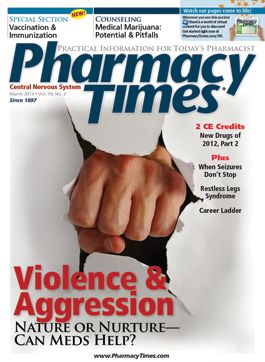Publication
Article
Pharmacy Times
A Continued Call to Action
Author(s):
Increasing public awareness of venous thromboembolism can help to encourage preventive medical attention.
Increasing public awareness of venous thromboembolism can help to encourage preventive medical attention.
What do world-renowned tennis champion Serena Williams, New York Yankee Mariano Rivera, television personality and entertainer Nick Cannon, and former Secretary of State Hillary Rodham Clinton have in common other than fame? They are each survivors of venous thromboembolism (VTE), which comprises deep vein thrombosis (DVT) and pulmonary embolism (PE). It is evident that blood clots do not discriminate. They can occur at any age, within any race, to any gender, and at any time.
Millions of people develop blood clots worldwide annually, with an estimated 300,000 leading to fatal outcomes in the United States alone. Hillary Clinton was recently diagnosed with right transverse venous sinus thrombosis, a distinct and rare type of DVT. The estimated incidence of this is 3 to 4 cases per 1 million. Greater than 80% of survivors of this cerebrovascular disorder have good neurologic outcomes.1 As with more common VTE events, prothrombotic risk factors are often identified as being the direct cause.
A century and a half ago, German pathologist Rudolph Virchow postulated that a triad of factors could result in increased risk of thrombus formation.2 Over the years, the factors have been refined to the following:
- Circulatory stasis
- Vascular injury/trauma
- Hypercoagulable state
Specific to the presentation of sinus thrombosis, the most typical presentation is that of women of child-bearing age. Notably, men and women were equally affected until the mid-1970s, whereby evidence suggests that with increased use of oral contraception, women are now at greater risk.3,4 While Clinton’s presentation was not entirely typical, she did possess other prothrombotic risk factors, such as prior DVT and recent head trauma (a concussion).
Modern health care has redirected its focus to a health care model of proactive versus reactive care. Between the more recent media attention secondary to celebrity exposure of the disease and the Surgeon General’s “Call to Action (CTA) to Prevent Deep Vein Thrombosis (DVT) and Pulmonary Embolism (PE)” in September 2008, blood clot has become a household term and public health efforts to increase DVT and PE awareness and prevention have increased. Still, more work needs to be done in raising awareness and engaging patients to adopt a philosophy of disease prevention.
Signs and Symptoms
In many instances, clinical presentation of clotting events occurs in the outpatient realm. With this in mind, it is important to identify the signs and symptoms. Notably, patient presentation can be highly variable and symptoms, such as headache, can be non-specific. Recent celebrity cases of VTE that have included Williams and Rivera have shaken the public’s perception that this disease only affects an older population. Patients who are young or middle-aged may experience stroke-like symptoms with or without neurological consequences, such as seizures, and/ or behavioral symptoms, such as delirium, amnesia, or worse—coma when presenting with sinus venous thrombosis.1
In some instances, diagnosis can take up to 1 week via magnetic resonance imaging (MRI) from the onset of symptoms. The most effective diagnostic evaluation may use MRI in combination with magnetic resonance venography. Patients typically respond positively to anticoagulation treatment with intravenous unfractionated heparin followed by management with oral vitamin K antagonists, such as warfarin.
The duration of anticoagulation management is highly dependent on the patient’s risk for recurrence versus the risk for bleeding. It has been shown that 40% of sinus thrombosis patients have the propensity to experience hemorrhagic infarcts. Furthermore, it is important to note that clots beget clots and patients having experienced primary VTE remain at risk for VTE recurrence. A long-term prospective study reported the cumulative incidence of VTE recurrence at 1 year, 5 years, and 10 years as 11%, 29%, and 40%, respectively.5
Clotting is not a disease that discriminates based on celebrity, but it deserves celebrity status. Pharmacists can continue to play a role in the prevention of VTE and its consequences by counseling patients on the conditions that may contribute to clot formation and helping to identify the signs and symptoms to aid patients who may need to seek preventive medical attention.
Dr. Stevens is an advanced practice anticoagulation pharmacist for the Partners Healthcare System and an adjunct clinical assistant professor of pharmacy at Northeastern University’s Bouvé College of Health Sciences in Boston, Massachusetts. This column’s information is based on current studies and references, but it may be updated without notice with newer studies or with different populations.
References
- Stam J. Thrombosis of the cerebral veins and sinuses. N Engl J Med. 2005;352:1791-1798.
- Merli GJ. Pathophysiology of venous thrombosis, thrombophilia, and the diagnosis of deep vein thrombosis-pulmonary embolism in the elderly. Clin Geriatr Med. 2006;22(1):75-92, viii-ix.
- Martinelli I, Sacchi E, Landi G, Taioli E, Duca F, Mannucci PM. High risk of cerebral-vein thrombosis in carriers of a prothrombin-gene mutation and in users of oral contraceptives. N Engl J Med. 1998;338:1793-1797.
- de Bruijn SF, Stam J, Koopman MM, Vandenbroucke JP; the Cerebral Venous Sinus Thrombosis Study Group. Case-control study of risk of cerebral sinus thrombosis in oral contraceptive users and in [correction of who are] carriers of hereditary prothrombotic conditions [published correction appears in BMJ. 1998;316(7134):822]. BMJ. 1998;316(7131):589-592.
- Prandoni P, Noventa F, Ghirarduzzi A, et al. The risk of recurrent venous thromboembolism after discontinuing anticoagulation in patients with acute proximal deep vein thrombosis or pulmonary embolism: a prospective cohort study in 1,626 patients. Haematologica. 2007;92:199-205.







